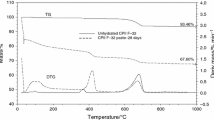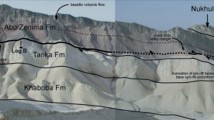Abstract
Gypsum quantitative determination in cements may be done from their thermogravimetric analysis (TG) data, which uses the mass of the water released from its gypsum dehydration during cement analysis, to determinate its content stoichiometrically. Depending on the operational conditions used to mill the gypsum with clinker, its partial dehydration may occur, which leads to unreal results when only unhydrated cement TG data are used. To solve this problem, TG analysis of the 1-h paste of respective cement must be done on respective initial cement mass basis. The method was applied to four different classes of Portland cements, showing that for all of them, the application of the method was needed to avoid erroneous determinations. As mineral composition data show that the cements have other sulfated phases, different from gypsum and its dehydration phases, the total cement SO3 content cannot be used directly to quantify gypsum. However, using the present suggested thermogravimetric method, the original gypsum content can be determined, which also estimates and includes the amount which was consumed to form ettringite during the first hour of hydration.






Similar content being viewed by others
References
Hewlett PC. Lea’s chemistry of cement and concrete, 4th edn. London: Arnold; 1998.
Taylor HFW. Cement chemistry. 2nd ed. Langholm: Thomas Telford; 1997.
Dweck J, Büchler MP, Coelho ACV, Cartledge FK. Solidification/stabilization of a tannery waste with blended cement and wyoming bentonite. J Environ Sci Health. 2000;A35(5):715–40.
Dweck J, Ferreira da Silva PF, Aderne RS, Büchler MP, Cartledge FK. Evaluating cement hydration by non-conventional DTA—an application to waste solidification. J Therm Anal Calorim. 2003;71:821–7.
Dweck J, Aderne RS. The effect of the presence of pozzolanic material in the solidification of a tannery waste. In: Proceedings of III seminar on pollution prevention and control DEQ/EPUSP, São Paulo, 2007. p. 20–29 (in Portuguese).
Silva DM, Alberoni VG, Dweck J, Yokoyama L. A thermal analysis study of the stabilization/solidification of a waste containing aluminum. In: Proceedings of II seminar on pollution prevention and control DEQ/EPUSP, São Paulo, 2005. p. 1–7 (in Portuguese).
Dweck J, Pinto AP, Büchler PM. Study of a Brazilian spent catalyst as cement aggregate by thermal and mechanical analysis. J Therm Anal Calorim. 2008;92(1):121–7.
Cunha ALC, Gonçalves JP, Büchler PM, Dweck J. Effect of metakaolin pozzolanic activity in the early stages of cement type II paste and mortar hydration. J Therm Anal Calorim. 2008;92(1):115–9.
Melchert MBM, Viana MM, Lemos MS, Dweck J, Büchler PM. Simultaneous solidification of two catalyst wastes and their effect on the early stages of cement hydration. J Therm Anal Calorim. 2011;105(2):625–33.
Dweck J, Büchler MP, Coelho ACV, Cartledge FK. Hydration of a Portland cement blended with calcium carbonate. Thermochim Acta. 2000;346:105–13.
Dweck J, Souza Santos P. A prototype system for thermogravimetric analysis. Cerâmica. 1989;35(39):169–75 (in Portuguese).
Angeleri FB, Cardoso SR, Souza Santos P. Gypsum characterization. Ceramica. 1983;29(160):93–8 (in Portuguese).
Blaine R, Dunn J, Patel J, Sills I. Gypsum DSC. TA Hotline. 1996;1:2.
Syndicat National des Industries de Platre. Le Platre—Physico-chemie, Fabrication et Emplois, Paris: Eyrolles; 1982. p. 84.
Cunha ALC, Gonçalves JP, Cartledge FK, Toledo Filho RD, Fairbairn EMR, Dweck J. Evaluation of the metakaolin pozzolanic reactivity in cement pastes. Mater Sci Forum. 2008;591–593:827–32.
Dweck J. Gypsum molds—a micro-processed system to determinate the Plaster of Paris hydration time and the water absorption rate. In: Proceedings of 39th Braz. Ceram. Congress. Águas de Lindóia, Brazil 1995. p. 1052–1057 (in Portuguese).
Neves A Jr, ToledoFilho RD, Fairbaim EMR, Dweck J. Early stages hydration of high initial strength Portland cement, Part I. Thermogravimetric analysis on calcined mass basis. J Therm Anal Calorim. 2012;108:725–31.
Dweck J, Melchert MB, Viana MM, Cartledge FK, Büchler PM. Importance of quantitative thermogravimetry on initial cement mass basis to evaluate the hydration of cement pastes and mortars. J Therm Anal Calorim. 2013;111(3):1–10.
Neves Junior A, Toledo Filho RD, Fairbairn EMR, Dweck J. CO2 sequestration by high initial strength Portland cement pastes. J Therm Anal Calorim 2013; 113:1–8.
Acknowledgements
The authors thank the Brazilian National Research Council—CNPq, and the Chemistry Department of the Louisiana State University.
Author information
Authors and Affiliations
Corresponding author
Rights and permissions
About this article
Cite this article
Jo, D., Leonardo, R.S., Cartledge, F.K. et al. Gypsum content determination in Portland cements by thermogravimetry. J Therm Anal Calorim 123, 1053–1062 (2016). https://doi.org/10.1007/s10973-015-5078-y
Received:
Accepted:
Published:
Issue Date:
DOI: https://doi.org/10.1007/s10973-015-5078-y




